Xiaojun Quan
ProactiveEval: A Unified Evaluation Framework for Proactive Dialogue Agents
Aug 28, 2025Abstract:Proactive dialogue has emerged as a critical and challenging research problem in advancing large language models (LLMs). Existing works predominantly focus on domain-specific or task-oriented scenarios, which leads to fragmented evaluations and limits the comprehensive exploration of models' proactive conversation abilities. In this work, we propose ProactiveEval, a unified framework designed for evaluating proactive dialogue capabilities of LLMs. This framework decomposes proactive dialogue into target planning and dialogue guidance, establishing evaluation metrics across various domains. Moreover, it also enables the automatic generation of diverse and challenging evaluation data. Based on the proposed framework, we develop 328 evaluation environments spanning 6 distinct domains. Through experiments with 22 different types of LLMs, we show that DeepSeek-R1 and Claude-3.7-Sonnet exhibit exceptional performance on target planning and dialogue guidance tasks, respectively. Finally, we investigate how reasoning capabilities influence proactive behaviors and discuss their implications for future model development.
Discriminative Policy Optimization for Token-Level Reward Models
May 29, 2025Abstract:Process reward models (PRMs) provide more nuanced supervision compared to outcome reward models (ORMs) for optimizing policy models, positioning them as a promising approach to enhancing the capabilities of LLMs in complex reasoning tasks. Recent efforts have advanced PRMs from step-level to token-level granularity by integrating reward modeling into the training of generative models, with reward scores derived from token generation probabilities. However, the conflict between generative language modeling and reward modeling may introduce instability and lead to inaccurate credit assignments. To address this challenge, we revisit token-level reward assignment by decoupling reward modeling from language generation and derive a token-level reward model through the optimization of a discriminative policy, termed the Q-function Reward Model (Q-RM). We theoretically demonstrate that Q-RM explicitly learns token-level Q-functions from preference data without relying on fine-grained annotations. In our experiments, Q-RM consistently outperforms all baseline methods across various benchmarks. For example, when integrated into PPO/REINFORCE algorithms, Q-RM enhances the average Pass@1 score by 5.85/4.70 points on mathematical reasoning tasks compared to the ORM baseline, and by 4.56/5.73 points compared to the token-level PRM counterpart. Moreover, reinforcement learning with Q-RM significantly enhances training efficiency, achieving convergence 12 times faster than ORM on GSM8K and 11 times faster than step-level PRM on MATH. Code and data are available at https://github.com/homzer/Q-RM.
ThinkSwitcher: When to Think Hard, When to Think Fast
May 20, 2025Abstract:Large reasoning models (LRMs) excel at solving complex tasks by leveraging long chain-of-thought (CoT) reasoning. However, this often leads to overthinking on simple tasks, resulting in unnecessary computational overhead. We observe that LRMs inherently possess the capability for efficient short CoT reasoning, which can be reliably elicited through prompt design. To leverage this capability, we propose ThinkSwitcher, a framework that enables a single LRM to dynamically switch between short and long CoT modes based on task complexity. ThinkSwitcher introduces a lightweight switching module trained with supervision signals derived from the relative performance of each reasoning mode across tasks. Experiments on multiple reasoning benchmarks show that ThinkSwitcher reduces computational cost by 20-30% while maintaining high accuracy on complex tasks. This demonstrates the effectiveness of ThinkSwitcher as a scalable and efficient solution for unified LRM deployment.
FuseRL: Dense Preference Optimization for Heterogeneous Model Fusion
Apr 09, 2025Abstract:Heterogeneous model fusion enhances the performance of LLMs by integrating the knowledge and capabilities of multiple structurally diverse models. However, existing approaches often rely solely on selecting the best output for each prompt from source models, which underutilizes their full potential due to limited source knowledge and results in sparse optimization signals. To address this limitation, we propose FuseRL, a novel two-stage framework comprising FuseSFT and FusePO to maximize the utilization of source LLMs. FuseSFT establishes a robust initialization by integrating the strengths of heterogeneous source models through weighted supervised fine-tuning (SFT) on diverse outputs for each prompt. FusePO optimizes weighted preferences based on the outputs of multiple source models to enable superior alignment performance. Extensive experiments demonstrate the effectiveness of our framework across various preference alignment methods, including RLOO, DPO, and SimPO. Using Llama-3.1-8B-Instruct as the target model, our approach achieves state-of-the-art performance among 8B LLMs on the AlpacaEval-2 and Arena-Hard benchmarks. Further analysis suggests that FuseSFT regularizes the training process to reduce overfitting, while FusePO introduces dense and diverse signals for preference optimization.
FuseChat-3.0: Preference Optimization Meets Heterogeneous Model Fusion
Mar 06, 2025Abstract:We introduce FuseChat-3.0, a suite of large language models (LLMs) developed by integrating the strengths of heterogeneous source LLMs into more compact target LLMs. Our source models include the powerful Gemma-2-27B-it, Mistral-Large-Instruct-2407, Qwen-2.5-72B-Instruct, and Llama-3.1-70B-Instruct. For target models, we focus on three widely-used smaller variants-Llama-3.1-8B-Instruct, Gemma-2-9B-it, and Qwen-2.5-7B-Instruct-along with two ultra-compact options, Llama-3.2-3B-Instruct and Llama-3.2-1B-Instruct. To leverage the diverse capabilities of these source models, we develop a specialized data construction protocol tailored to various tasks and domains. The FuseChat-3.0 training pipeline consists of two key stages: (1) supervised fine-tuning (SFT) to align the target and source model distributions, and (2) Direct Preference Optimization (DPO) to apply preferences from multiple source LLMs to fine-tune the target model. The resulting FuseChat-3.0 models exhibit significant performance gains across tasks such as instruction following, general knowledge, mathematics, and coding. As illustrated in Figure 1, using Llama-3.1-8B-Instruct as the target model, our fusion approach achieves an average improvement of 6.8 points across 14 benchmarks. Moreover, it demonstrates remarkable gains of 37.1 points and 30.1 points on the instruction-following benchmarks AlpacaEval-2 and Arena-Hard, respectively. Our code, models, and datasets are available at https://github.com/SLIT-AI/FuseChat-3.0.
Advantage-Guided Distillation for Preference Alignment in Small Language Models
Feb 25, 2025Abstract:Alignment techniques enable Large Language Models (LLMs) to generate outputs that align with human preferences and play a crucial role in their effectiveness. However, their impact often diminishes when applied to Small Language Models (SLMs), likely due to the limited capacity of these models. Instead of directly applying existing alignment techniques to SLMs, we propose to utilize a well-aligned teacher LLM to guide the alignment process for these models, thereby facilitating the transfer of the teacher's knowledge of human preferences to the student model. To achieve this, we first explore a straightforward approach, Dual-Constrained Knowledge Distillation (DCKD), that employs knowledge distillation with two KL-divergence constraints from the aligned teacher to the unaligned student. To further enhance the student's ability to distinguish between preferred and dispreferred responses, we then propose Advantage-Guided Distillation for Preference Alignment (ADPA), which leverages an advantage function from the aligned teacher to deliver more nuanced, distribution-level reward signals for the student's alignment. Our experimental results show that these two approaches appreciably improve the alignment of SLMs and narrow the performance gap with larger counterparts. Among them, ADPA demonstrates superior performance and achieves even greater effectiveness when integrated with DCKD. Our code is available at https://github.com/SLIT-AI/ADPA.
PsyPlay: Personality-Infused Role-Playing Conversational Agents
Feb 06, 2025Abstract:The current research on Role-Playing Conversational Agents (RPCAs) with Large Language Models (LLMs) primarily focuses on imitating specific speaking styles and utilizing character backgrounds, neglecting the depiction of deeper personality traits.~In this study, we introduce personality-infused role-playing for LLM agents, which encourages agents to accurately portray their designated personality traits during dialogues. We then propose PsyPlay, a dialogue generation framework that facilitates the expression of rich personalities among multiple LLM agents. Specifically, PsyPlay enables agents to assume roles with distinct personality traits and engage in discussions centered around specific topics, consistently exhibiting their designated personality traits throughout the interactions. Validation on generated dialogue data demonstrates that PsyPlay can accurately portray the intended personality traits, achieving an overall success rate of 80.31% on GPT-3.5. Notably, we observe that LLMs aligned with positive values are more successful in portraying positive personality roles compared to negative ones. Moreover, we construct a dialogue corpus for personality-infused role-playing, called PsyPlay-Bench. The corpus, which consists of 4745 instances of correctly portrayed dialogues using PsyPlay, aims to further facilitate research in personalized role-playing and dialogue personality detection.
Weighted-Reward Preference Optimization for Implicit Model Fusion
Dec 04, 2024



Abstract:While fusing heterogeneous open-source LLMs with varying architectures and sizes can potentially integrate the strengths of different models, existing fusion methods face significant challenges, such as vocabulary alignment and merging distribution matrices. These procedures are not only complex but also prone to introducing noise and errors. In this paper, we propose an implicit fusion method, Weighted-Reward Preference Optimization (WRPO), which leverages preference optimization between the source LLMs and the target LLM to transfer their capabilities effectively. WRPO eliminates the need for vocabulary alignment and matrix fusion and can be efficiently scaled to accommodate various LLMs. To address distributional deviations between the source and target LLMs, WRPO introduces a progressive adaptation strategy that gradually shifts reliance on preferred examples from the target LLM to the source LLMs. Extensive experiments on the MT-Bench, AlpacaEval-2, and Arena-Hard benchmarks demonstrate that WRPO consistently outperforms existing knowledge fusion methods and various fine-tuning baselines. When applied to LLaMA3-8B-Instruct as the target model, WRPO achieves a length-controlled win rate of 55.9% against GPT-4-Preview-1106 on AlpacaEval-2 and a win rate of 46.2% against GPT-4-0314 on Arena-Hard. Our code is available at \url{https://github.com/SLIT-AI/WRPO}.
ProFuser: Progressive Fusion of Large Language Models
Aug 09, 2024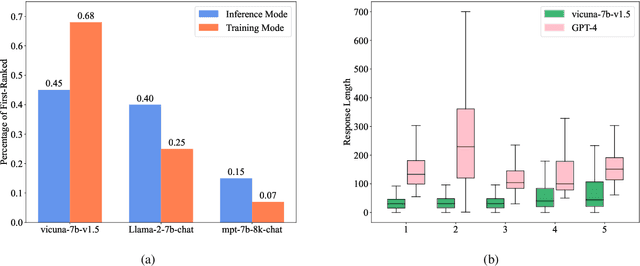

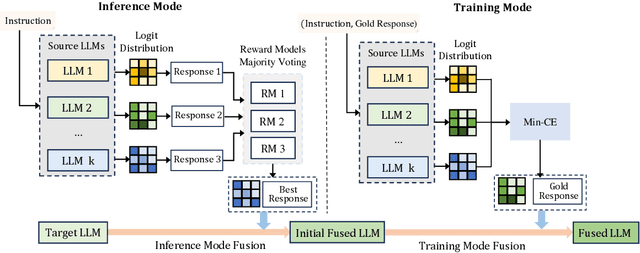
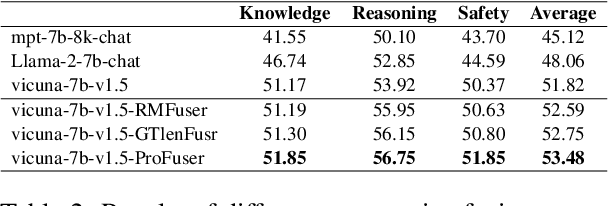
Abstract:While fusing the capacities and advantages of various large language models (LLMs) offers a pathway to construct more powerful and versatile models, a fundamental challenge is to properly select advantageous model during the training. Existing fusion methods primarily focus on the training mode that uses cross entropy on ground truth in a teacher-forcing setup to measure a model's advantage, which may provide limited insight towards model advantage. In this paper, we introduce a novel approach that enhances the fusion process by incorporating both the training and inference modes. Our method evaluates model advantage not only through cross entropy during training but also by considering inference outputs, providing a more comprehensive assessment. To combine the two modes effectively, we introduce ProFuser to progressively transition from inference mode to training mode. To validate ProFuser's effectiveness, we fused three models, including vicuna-7b-v1.5, Llama-2-7b-chat, and mpt-7b-8k-chat, and demonstrated the improved performance in knowledge, reasoning, and safety compared to baseline methods.
Cool-Fusion: Fuse Large Language Models without Training
Jul 29, 2024
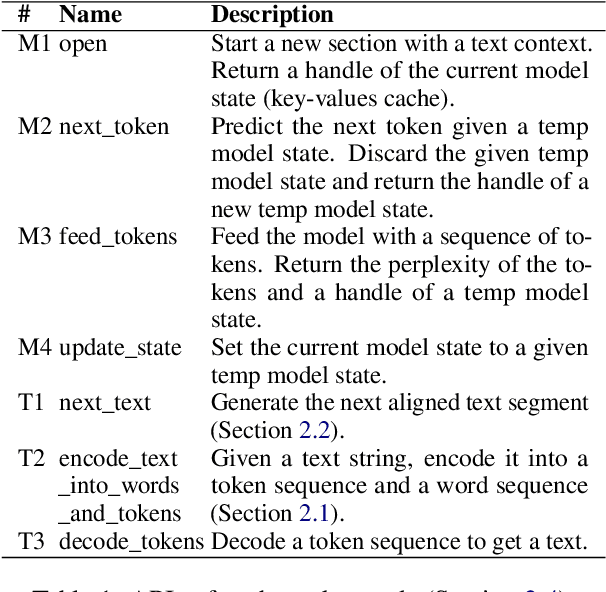
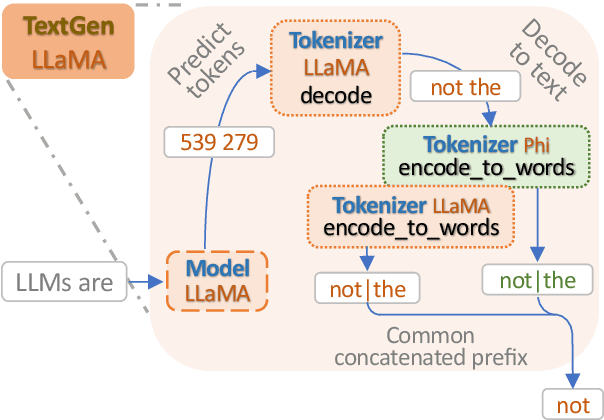

Abstract:We focus on the problem of fusing two or more heterogeneous large language models (LLMs) to facilitate their complementary strengths. One of the challenges on model fusion is high computational load, i.e. to fine-tune or to align vocabularies via combinatorial optimization. To this end, we propose \emph{Cool-Fusion}, a simple yet effective approach that fuses the knowledge of heterogeneous source LLMs to leverage their complementary strengths. \emph{Cool-Fusion} is the first method that does not require any type of training like the ensemble approaches. But unlike ensemble methods, it is applicable to any set of source LLMs that have different vocabularies. The basic idea is to have each source LLM individually generate tokens until the tokens can be decoded into a text segment that ends at word boundaries common to all source LLMs. Then, the source LLMs jointly rerank the generated text segment and select the best one, which is the fused text generation in one step. Extensive experiments are conducted across a variety of benchmark datasets. On \emph{GSM8K}, \emph{Cool-Fusion} increases accuracy from three strong source LLMs by a significant 8\%-17.8\%.
 Add to Chrome
Add to Chrome Add to Firefox
Add to Firefox Add to Edge
Add to Edge